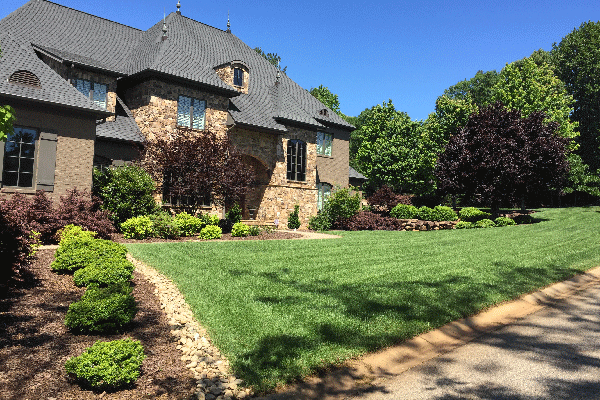Is a lawn and landscape an asset or a detriment? To answer this question, consider that:
- Oxygen production – 55 sq. ft. of turfgrass produces enough oxygen for one person for one day. [CO2 + H2O + light energy = carbohydrates/sugars + H2O + O2]
- Soil Organic Carbon Sequestration – the process through which CO2 from the atmosphere is absorbed by plants through photosynthesis. Carbon is stored in wood in trees and in the thatch and roots.
Approximately 40 million acres of lawns in the U.S. The better maintained the lawn is, the more carbon is sequestered, even though the inputs of mowing, pesticides, fertilizers, etc. use carbon sources; the net sequestration is 106-122 lbs. more than not having a lawn; the trees are a bonus.
Lawns are a carbon sink. With a lawn, you are offsetting the carbon footprint by 2.1%, which is not huge, but better than creating a negative carbon footprint. Nearly a ton of carbon per acre per year is stored in the thatch and roots of golf course fairways, tees, greens and roughs.
If people recycle grass clippings, leaving them to decompose on their property, U.S. lawns could store up to 37 billion pounds of carbon each year. - Cooling Effect/Heat Dissipation - The front lawn on a block of 8 average homes have the combined cooling effect of 70 tons of air conditioning. Turfgrass plants absorb some solar radiation to fuel the photosynthesis process. Roughly 50% of the sun’s heat striking the turf may be eliminated through the transpirational cooling process.
- Dust and Air Pollution -Lawns trap an estimated 12 million tons of dust and dirt released annually into the atmosphere.
- Soil Erosion - Lawns are relatively inexpensive, durable groundcovers that protect our valuable, nonrenewable soil resources from water and wind erosion.
- Mixed Landscapes – 25% fewer crimes occur in public housing with landscaping. -For every dollar invested in a landscape containing turf and trees, a return of $1.35 is yielded.
Additional Landscape Benefits
- 45 degrees lower temperatures are in parked cars shaded by trees.
- 7% higher rents are paid on commercial sites with functional and attractive landscaping.
- 48 pounds of CO2 are absorbed by 1 tree each year and produces enough oxygen to support 2 human beings. 3 trees properly placed around a home will save $100 to $250 annually in energy costs. Landscapes also play a substantial role in stormwater management and water quality.
- Pervious surfaces such as lawns, planting beds and patios that use permeable building materials help to treat stormwater runoff close to the source. When stormwater is slowed by moving through landscaped areas, the amount of runoff is reduced along with sedimentation of streams, rivers and lakes. This filtering process also cleans water of pollutants.
- Children who spend time out of doors in the landscape are better learners and have improved creativity, imagination, cognitive function and overall intellect. Children with ADD experience reduced symptoms when exposed to green environments, even if they only view it through a window.
- 66% of people prefer to retreat to a natural setting when stressed. Many health care facilities now implement landscaped areas known as healing gardens to provide green spaces for patient wellbeing. Studies done on people who were stressed, anxious or depressed found that 95% of people felt calmer and had a positive change in mood after spending a short time in a landscape.
- Finally, walking and pushing a lawnmower can burn up to 370 calories per hour.
Sources: Johnson, S. J., Koski, T. and A. S. O’Connor, The Hidden Value of Landscapes, Colorado State University, Benefits of Turfgrass, The Lawn Institute.

